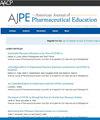Continuous Glucose Monitoring User-Wear Experience Fosters Empathy and Learning
IF 3.8
4区 教育学
Q1 EDUCATION, SCIENTIFIC DISCIPLINES
引用次数: 0
Abstract
Objective
To determine if a continuous glucose monitoring (CGM) user-wear experience brings value to an advanced diabetes elective course by assessing the impact on empathy and knowledge.
Methods
This was a quasi-experimental pre-post intervention study, conducted over 2 offerings of an advanced diabetes elective course. Third-year pharmacy students participated in a 2-part didactic education and user-wear experience involving CGM devices. Students completed a survey at 3 prespecified time points to assess empathy and knowledge (foundational and counseling knowledge). Empathy was assessed using the Kiersma-Chen empathy scale. Knowledge was assessed using predefined multiple-choice questions. Statistical tests include repeated measures analysis of variance and Bonferroni tests for overall and subsection scores on the empathy and knowledge surveys. A partial eta squared was also used to measure effect size for the repeated measures analysis of variance test.
Results
Twenty-nine out of the 36 enrolled students completed all 3 surveys. Compared with a traditional lecture, the CGM user-wear experience demonstrated a significant increase in student self-perceived empathy and counseling knowledge. No change in foundational knowledge was observed.
Conclusion
A CGM user-wear experience provides educational value beyond a traditional lecture. Our study showed that educational outcomes such as empathy and counseling knowledge can be achieved by implementing a CGM user-wear experience. An advanced diabetes elective course provides an ideal environment to optimize CGM learning outcomes with a user-wear experience.
连续血糖监测用户穿戴体验培养同理心和学习能力。
目的:通过评估对移情和知识的影响,确定连续血糖监测(CGM)用户穿戴体验是否为高级糖尿病选修课程带来价值。方法:这是一项准实验性的干预前后研究,在两门晚期糖尿病选修课程中进行。药学三年级的学生参加了涉及CGM设备的两部分教学教育和用户佩戴体验。学生们在三个预先指定的时间点完成了一项调查,以评估同理心和知识(基础知识和咨询知识)。共情采用Kiersma-Chen共情量表进行评估。知识评估使用预先定义的多项选择题。统计检验包括重复测量方差分析(ANOVA)和Bonferroni检验共情和知识调查的总体和分段得分。偏eta平方也用于测量重复测量ANOVA检验的效应大小。结果:36名在校生中有29名完成了所有三项调查。与传统讲座相比,CGM用户穿戴体验显著提高了学生的自我感知同理心和咨询知识。没有观察到基础知识的变化。结论:CGM用户佩戴体验提供了超越传统讲座的教育价值。我们的研究表明,通过实施CGM用户穿戴体验,可以实现移情和咨询知识等教育成果。高级糖尿病选修课程提供了一个理想的环境,以优化CGM的学习成果与用户穿戴体验。
本文章由计算机程序翻译,如有差异,请以英文原文为准。
求助全文
约1分钟内获得全文
求助全文
来源期刊
CiteScore
4.30
自引率
15.20%
发文量
114
期刊介绍:
The Journal accepts unsolicited manuscripts that have not been published and are not under consideration for publication elsewhere. The Journal only considers material related to pharmaceutical education for publication. Authors must prepare manuscripts to conform to the Journal style (Author Instructions). All manuscripts are subject to peer review and approval by the editor prior to acceptance for publication. Reviewers are assigned by the editor with the advice of the editorial board as needed. Manuscripts are submitted and processed online (Submit a Manuscript) using Editorial Manager, an online manuscript tracking system that facilitates communication between the editorial office, editor, associate editors, reviewers, and authors.
After a manuscript is accepted, it is scheduled for publication in an upcoming issue of the Journal. All manuscripts are formatted and copyedited, and returned to the author for review and approval of the changes. Approximately 2 weeks prior to publication, the author receives an electronic proof of the article for final review and approval. Authors are not assessed page charges for publication.

 求助内容:
求助内容: 应助结果提醒方式:
应助结果提醒方式:


